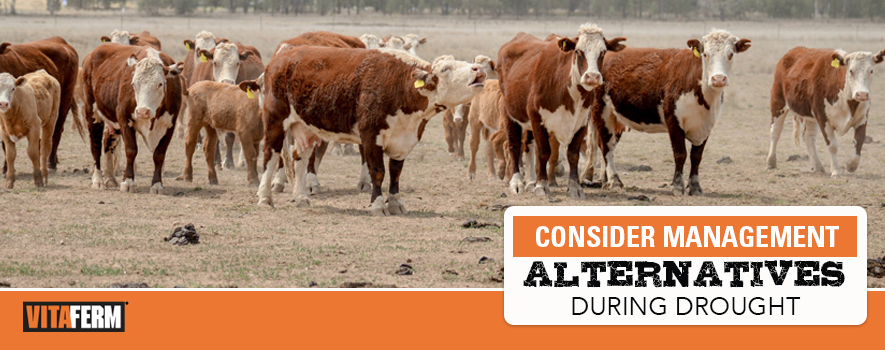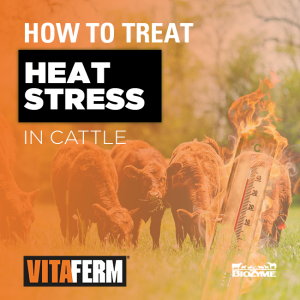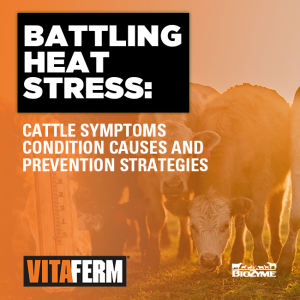
By Jack Oattes, M.S., BioZyme Inc.
Unpredictable and often extreme weather conditions are just some of the many challenging obstacles that beef cattle producers across the United States regularly contend with while working hard to supply food to a growing population.
Throughout 2021, many cattle producers have been feeling the effects of extremely dry conditions that have had a negative impact on production outcomes. These drought conditions have resulted in decreased pasture resources and overall forage and feedstuff availability while further compounding the record high feed prices the industry has witnessed over the course of the last year. This article aims to shed some light on nutrition and management strategies for producers to consider in order to make the best of drought conditions. While it should be noted that every operation is unique, and what works for some operations may not be the answer for others, there are still many considerations that are widely applicable and worth reviewing.
Historically, feed costs on a typical beef enterprise account for 50-70% of production costs, and with the elevated prices of feed inputs during this time, it is reasonable to expect that percentage has grown. As such, it is important to closely consider the concept of efficiency, and make sure that as a producer, you are doing everything possible to ensure your cowherd is making the most of your resources. This includes having genetics that match your production environment as well as employing other technologies such as Amaferm® into your nutritional program. Amaferm is a research-proven prebiotic that optimizes digestibility and absorption of nutrients and is available as part of the products in the BioZyme® portfolio. While these considerations can have a positive impact year-round, the benefits of increasing efficiency are magnified during drought conditions when feed resources are limited.
Producers may also want to consider the use of alternative feedstuffs at this time. Thinking outside the box and considering feedstuffs that may not normally be a part of your supplementation plan can certainly pay off. When doing this, feed testing is very important in order to understand the dynamics of the feedstuff and plan to optimize its use. Further, matching available feedstuffs to the nutritional demands of the cowherd is also important. Depending on the stage of production, consider utilizing your lowest quality forages during times when cows have the lowest nutritional requirements such as when not lactating or during early to mid-gestation, and save more desirable forages for times when nutritional requirements are high, such as late gestation through peak lactation.
Another consideration and perhaps one that requires more time to execute and may not be of immediate benefit during extreme drought conditions but is certainly worthwhile is to consider seeding an annual crop as a forage source to supplement the continued grazing of perennial pastures. Further, when rotating pastures during drought-stricken conditions, allow for more rest time between grazing periods in order to give the forage stand more opportunity for regrowth. Grazing failed crops or hay stands can also be worthwhile, but keep in mind that stressed plants can be more likely to accumulate high levels of toxic compounds such as nitrates or prussic acid. It is best to monitor cattle closely when grazing, and if suspected, remove cattle from access and consult the advice of your nutritionist and veterinarian.
Creep feeding is a practice that aims to directly supplement calves while they remain nursing at the side of their dam. By supplementing calves directly, it can help to overcome some of the nutritional shortfalls that calves face with lowered milk production due to limited nutritional availability to the cow. There are a host of BioZyme products that can play a role in your creep feeding scenario, and it might be wise to consult your local BioZyme dealer or Area Sales Manager to discuss options. Alternatively, early weaning calves has proven to be beneficial and is a topic with a significant amount of research to credit its viability. Not only can early weaning lessen the nutritional burden on the cowherd to lactate, but it can also minimize the strain on pastures by reducing the stocking density. If feed resources are available for calves this can be beneficial. There are several BioZyme products that benefit early weaned calves such as the Vita Charge® line of products, which are fast-acting supplements for use during stressful times when cattle need protection or assistance in recovery. Also, Gain Smart® is a line of vitamin and mineral supplements for beef cattle with the Amaferm advantage that promotes economically produced pounds by maximizing the natural energy and protein available in forage and has several formulations that can benefit young and growing cattle following weaning.
As previously mentioned, one of the most important considerations during periods of limited feed availability is focusing on efficiency. VitaFerm Conserve® is an economical line of vitamin and mineral supplements for cattle that allows for producers to conserve costs while still improving performance of the herd and making the most of available feedstuffs. This is achieved through the inclusion of Amaferm as well as a complete vitamin and mineral pack. Further, VitaFerm Conserve® is available in six different formulas, each with unique features tailored to different challenges that producers face.
All in all, there are numerous cattle management strategies that can be considered during periods of drought to benefit producers and their cowherd. Be sure to reach out to your local Area Sales Manager or BioZyme dealer to discuss the options that may be right for you. BioZyme is proud to provide solutions and be of service to the cattle producers that help to feed the world.


